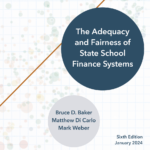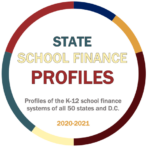Visualization: K-12 revenue progressivity
Select a state and year (1993-2021) to display a graph summarizing the progressivity (or “fairness”) of state and local revenue to public K-12 schools. The three bars in the graph represent, for a given state in a given year, the percent difference in adjusted state and local revenue between:
- Low (10%) poverty districts and zero poverty districts;
- Medium (20%) poverty districts and zero poverty districts;
- High (30%) poverty districts and zero poverty districts.
Negative numbers indicate regressive funding (low/ medium/ high poverty districts receive less revenue than zero poverty districts), whereas positive numbers indicate progressive funding (low/ medium/ high poverty districts receive more revenue than zero poverty districts). District poverty is measured with U.S. Census data, and the “predicted” revenue estimates used in these comparisons also control for labor market costs, population density, and district size. Note that progressivity estimates are not available for Hawaii and the District of Columbia, as both contain only one government-run school district. For more information on these measures, see our State Indicators Database user’s guide and our annual report. You can also download the full dataset.
Note: if you get an “unexpected error” message when attempting to load the Tableau visualization, try enabling third party cookies in your web browser.
Latest News
 SIXTH EDITION OF OUR ANNUAL REPORT AND OTHER RESOURCES
SIXTH EDITION OF OUR ANNUAL REPORT AND OTHER RESOURCES
January 2024: Read our annual report summarizing the national results, download your state’s one-page profile, view results using our online data visualizations, or download the full dataset.
Latest Annual Report
 The Adequacy and Fairness of State School Finance Systems (sixth edition)
The Adequacy and Fairness of State School Finance Systems (sixth edition)
The sixth edition of our annual report presenting findings on effort, statewide adequacy, and equal opportunity in state school finance systems. Published January 2024.
Latest Research Briefs
 State School Finance System Profiles (2020-21 school year)
State School Finance System Profiles (2020-21 school year)
One-page profiles summarizing the key results on effort, statewide adequacy, and equal opportunity for all 50 states and D.C. View your state’s profile. Published January 2024.




